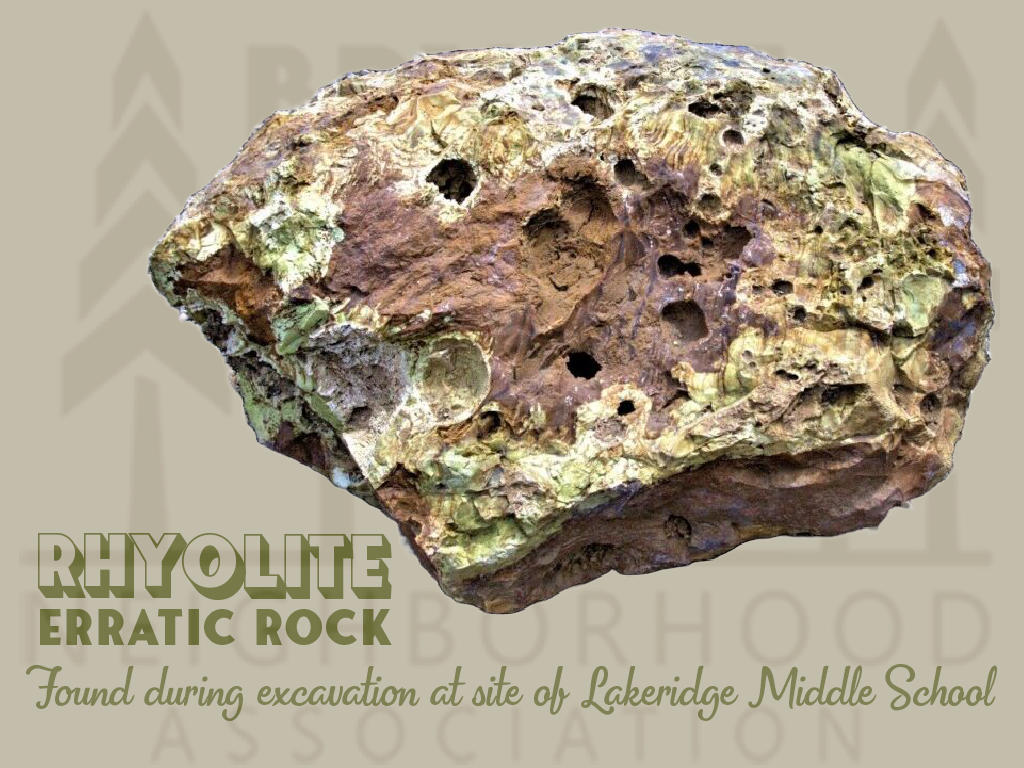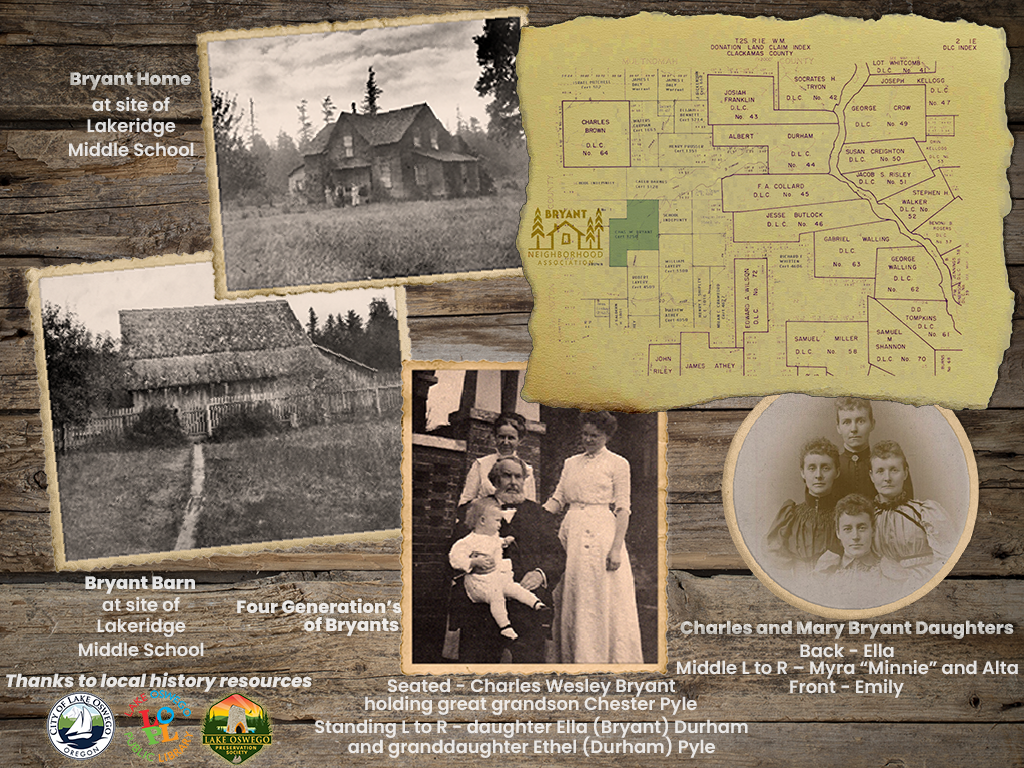During the last ice age some 15,000 years ago, giant Lake Missoula in western Montana burst through an ice dam, sending a torrent of water down the Columbia River and the Willamette Valley. Every few decades for several hundred years, the lake refilled until it pushed through again. The zooming floodwaters led to erosion and scour zones near modern-day Lake Oswego and Oregon City, including enlarging the old Oswego channel to create Oswego Lake. Chunks of ice embedded with rocks floated in the surge and ran aground as waters subsided, the ice melted and deposited the rocks in Oregon.
In May of 2021, during the excavation of the new Lakeridge Middle School parking lot, one of the rocks caught the eye of a construction crew member. A local geologist was contacted. It was a very, very rare rock from east of the Cascades, and carried here by the Missoula Floods. Only one other rock like it has ever been found in our area. The 2000-pound rock is known as rhyolite and is created by layers of cooling lava, usually from close to the earth’s surface.
The rock is now part of the Ice Age flood exhibit at the Tualatin Heritage Center.
Alvarez Zeller, Asia, “Quite the find: Ancient rock found at Lakeridge construction site,” pamplinmedia.com, URL, Jun 3, 2021~15,000 Years Ago
Prehistoric People
Lake Oswego’s location is one of the oldest inhabited areas in the Willamette Valley, occupied by prehistoric people for more than 6100 years. Before Euro-Americans arrived in Oregon, the homelands of two tribes covered the vicinity of Lake Oswego. The area near the river was occupied by the Clowewalla band of the Clackamas Chinook Indians. The land west of the lake was the homeland of the Tualatin band of the Kalapuya people. According to early settlers, the Indians called Sucker Lake, now Oswego Lake, "Waluga," after the wild swans that wintered there. All the Lake Oswego history stories talk about the origin of the name Waluga, but in one article there was mention that linguists have been unable to trace this word to local native dialects so it might have been a romanticized invention.
Fulton, Ann, "Iron, Wood and Water: An Illustrated History of Lake Oswego," HPNBooks, URL, 2002Colver, Marylou, “A Brief History of Lake Grove, Oregon,” Lake Oswego Preservation Society, URL, 2015Mid 1800s
Charles Wesley and Mary Fay Bryant were early pioneers in what is today the Lake Grove area. Charles, a carpenter and millwright, came from Java, New York with his wife in 1853 and a group of missionaries led by the Reverend Harvey K. Hines. The Bryant’s filed for and received a donation land claim that ran from the western head of Oswego Lake, along the main Oswego canal south towards the Tualatin River. They built their homestead where the Lakeridge Middle School now stands. Two of their children arrived with them and seven more were born in this home. The 320 acres were primarily used for hops, a prune orchard, and logging. Local legend says that Bryant introduced red clover to Oregon. It is also reputed that he was one of the few early settlers to learn the Chinook language, enabling him to converse with the Native Americans in the area.
Charles Wesley Bryant Obituary
Anonymous. 1915. C. W. Bryant passes. Pioneer, who introduced clover in Oregon, dies at 88. Oregonian (Portland, Oregon), p 13, Thursday 28 October 1915. "C. W. Bryant Passes"
Charles Wesley Bryant, a pioneer of 1853, died early yesterday morning at the residence of his daughter, Mrs. E. L. Lane, 1749 Wayland street, after a prolonged illness, at the age of 88 years and seven months.
Mr. Bryant was born in Allegany County, New York, March 28, 1827, of Irish and English ancestry. He married Miss Mary Elvira Fay on January 30, 1848. The young couple with two children left their early home on April 12, 1853, crossed the plains from St. Joseph, Mo., with ox teams, arrived at Portland October 3 of the same year, and at once located on a donation land claim at the head of Walluga Lake (Oswego Lake) in Clackamas County. While Mr. Bryant cleared up considerable land and cultivated the soil, his chief business for many years was that of milwrighting.
In the Fall of his first year in Oregon Mr. Bryant noticed the absence of red clover and inquired why it was not raised in Oregon.
"It will not grow in the Willamette Valley," he was informed. "I will prove that it will grow here," he said.
Suiting the action to the word he sent by way of the Isthmus to New York for one bushel of clover seed and it was sent in packets through the mail. It arrived in time to be sown upon his place in the latter part of April, 1854. From that time there was no further question raised about the growing of clover in almost all localities in Western Oregon.
Mrs. Bryant died several years ago, and was the mother of seven children, as follows: Mrs. Alta B. Young and Lee Bryant, born in New York; Mrs. E. C. Durham, Charles P. Bryant, Mrs. E. L. lane and Mrs. James Bell, Hale D. Bryant, born in Oregon. Lee Bryant died in childhood and Mrs. Bell died in July, 1910. Five children survive the father and mother, as follows: Mrs. Young, Mrs. Durham and Mrs. Lane, Portland; Hale D. Gaston; Charles P., Fresno, Cal. In addition there are 11 grandchildren and 16 great-grandchildren.
The funeral will take place at Finley's tomorrow at 1 o'clock.
He is buried in the River View Cemetery in Portland Oregon.
Dunis, Nancy, “History Connection: School just part of Bryant legacy,” pamplinmedia.com, URL, Dec 6, 2018Charles Wesley Bryant (1827-1915) - Find a Grave MemorialCharles Wesley Bryant 1827-1915 - Ancestry®Oregon Inventory of Historic Properties - Bryant Homesite MarkerCharles Wesley Bryant Obituary and other NW Pioneer ObiturariesInterested in local history or genealogy? Join the Lake Oswego Genealogy Interest Group.


